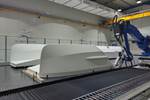Caracol delivers high-performance, customized 3D printed elements to Pershing sports utility yacht
Heron AM platform demonstrated its capability of fabricating complex superstructural composite parts for the luxury yachting industry with intricate geometries, more efficiency and less waste.
3D printed intake grilles. Source (All Images) | Caracol
The GTX116 sport utility yacht, produced by (Mondolfo, Italy), one of Ferretti Group’s seven brands, features the ways in which robotic large-format additive manufacturing (LFAM) technologies enable the efficient fabrication of complex, super-structural parts with intricate geometries. For this project, Caracol (Milano, Italy and Austin, Texas, U.S.) was commissioned to 3D print key elements for the new range of yachts, including side air intake grilles and windshield visors.
Yacht air grilles and other superstructures are traditionally produced through manual lamination of fiberglass on molds. This process requires multiple molds depending on the complexity of the geometry and involves intensive manual work by highly skilled labor, impacting production time and costs.
In contrast, LFAM eliminates the need for master molds and tools entirely, streamlining the production process. Caracol’s incorporation of the Heron AM system to this project — specializes in printing composites and polymers — achieved composite components featuring intricate geometries and highly customized designs that could be produced directly from the digital model, bypassing the manual lamination phase. Caracol notes that this reduces prototyping and production times, enabling rapid iterations and design optimizations. Moreover, the process only requires finishing operations such as gelcoat application, further cutting down on labor-intensive steps.

In addition to Heron AM’s use of lightweight materials, its flexibility allows for small-batch or fully customized production, catering to the specific needs of each project.
Adoption of LFAM led to the production of air grilles with improvements in efficiency, sustainability and overall product quality. Caracol used its Heron 300 system, equipped with a high-accuracy extruder and a 3-millimeter nozzle. The components were made from ASA reinforced with 20% glass fiber — a material chosen for its durability and resistance to harsh marine environments.
The 3D printing process took 72 hours to complete, producing an air grille measuring 4,200 × 400 × 400 millimeters and weighing 40 kilograms. Compared to traditional manufacturing methods, this approach has resulted in substantial reductions in lead time (50%), material waste (60%) and overall weight (15%).
To ensure both weather resistance and a flawless aesthetic, the grille was finished with a gelcoat, enhancing its durability against environmental exposure.
The resulting 35-meter Pershing GTX116 yacht, offering customers a sporty yet elegant style, is expected to elevate the seagoing experience.
Related Content
-
Al Seer Marine, Abu Dhabi Maritime unveil world’s largest 3D-printed boat
Holding the new Guinness World Record at 11.98 meters, the 3D-printed composite water taxi used a CEAD Flexbot to print two hulls in less than 12 days.
-
Infinite Composites: Type V tanks for space, hydrogen, automotive and more
After a decade of proving its linerless, weight-saving composite tanks with NASA and more than 30 aerospace companies, this CryoSphere pioneer is scaling for growth in commercial space and sustainable transportation on Earth.
-
McLaren develops aerospace-inspired ART method for volume composite super car engineering
Automated rapid tape (ART) technique, already deployed at the MCTC and to be used for future McLaren models, is capable of producing lighter, stiffer and stronger carbon fiber structures with less waste.






